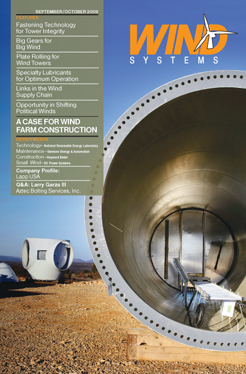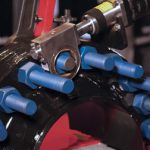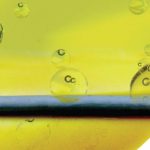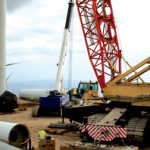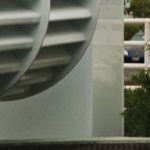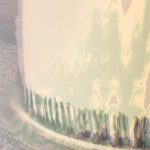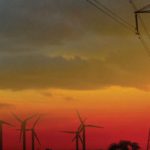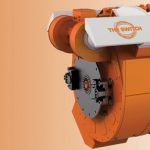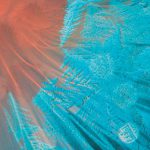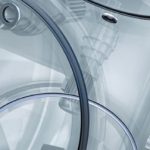Current economic conditions, rising energy prices, demand and supply uncertainties, and multiple environmental concerns are driving the United States to rethink its energy portfolio and develop diverse sources of clean, renewable energy. The nation is working toward generating more energy from domestic resources—energy that can be cost-effective and replaced, or “renewed,” without contributing to climate change or major adverse environmental impacts.
After experiencing strong growth in the mid-eighties the U.S. wind industry hit a plateau during the electricity-restructuring period in the nineties, and then regained momentum in 1999. Today the U.S. wind industry is growing rapidly, driven by sustained production tax credits (PTCs), rising concerns about climate change, and renewable portfolio standards (RPS) or goals in roughly 50 percent of the states.
U.S. turbine technology has advanced steadily, offering improved performance. In 2006 alone average turbine size increased by more than 11 percent over the 2005 level to an average size of 1.6 MW. In addition, average capacity factors have improved over 10 percent since 2007. To meet the growing demand for wind energy, U.S. manufacturers have expanded their capacity to produce and assemble the essential components. Despite this growth, U.S. components represent a relatively small share of total turbine and tower materials, and U.S. manufacturers are struggling to keep pace with rising demand (Wiser & Bolinger 2007).
Historical Perspective
The interest in composites for turbine manufacturing has evolved over time. Originally, steel was the main material used, but whenever something with that amount of weight is elevated to such a degree there are risks involved. Trying to find weight-saving solutions became a natural progression. The goals were to make turbines lighter while maintaining and even increasing the strength. Turbine transfer designs originated in Europe, and you’ll find some of the largest wind energy companies headquartered there due to their mature market. Global support for the wind industry development is found in the rising profiles of environmental issues and the vast improvements in the cost to make wind energy viable. The advanced use of composites is a contributing factor in the reduction of equipment cost. The United States began to show increased interest in this market about six years ago and, according to the U.S. Department of Energy’s Energy Efficiency and Renewable Energy Office it installed more new wind energy capacity in 2005 than any other country in the world.
Depending on the manufacturer, different aspects of a turbine are supplied. Components such as the blades and the cosmetic cover/nacelle of a turbine are parts that typically utilize thermoplastic and thermoset components. Some suppliers to the turbine manufacturers will supply only the parts needed, while others will supply complete assemblies. For instance, McClarin Plastics provides the nacelle housing, nose cone, and spinner hub in addition to value-added assembly work, which consists of installing items such as metal support brackets, electronic components, vents, doors, insulation, and cooling units or heaters into a larger assembly. This assembly work can include as many as 500 part numbers installed into 18 larger component parts, which are then shipped to the turbine OEM. Delivery can be assembled on location, thus decreasing the amount of labor needed. This alleviates the supply chain of ordering and inventorying component parts, which saves time, physical space, and money for the customer.
The Material
Even though metallics (steel and aluminum) are still notable in product design, material systems utilizing composites and plastics have become more prominent. With fiberglass customers found a lighter material offering a comparable lifespan and more cost-effective price tag that better withstood harsh environments. Design and engineering teams are constantly looking at ways to improve manufacturing and performance efficiencies. As the focus shifted to fiberglass, three types of processes took shape: chopper gun, vacuum infusion, and resin transfer molding.
By definition, fiberglass composite (thermoset) is a mixture of resin and glass strands. Manufacturers first used the hand lay-up or chopper gun methods, which incorporated chopped glass in a laminate mat with the resin applied manually. While the composite was lighter than steel, the chopped glass had inconsistent wall thickness and little-to-no structure in the laminate, which led to an unreliable strength reading. This resulted in stress cracks in the composites. The vacuum infusion and resin transfer molding (light) method evolved over time and soon became the industry standard because it allows fiberglass to be designed and purchased in an engineered mat.
In resin transfer molding (light) the resin is injected or drawn into a mold that contains the fibers from a homogenizer under low pressure. The mold can be made from composites for low production cycles or with aluminum or steel for larger production. The difference between composites and metals is better heat transfer with metal, hence quicker cycle times. Metal also lasts longer and deforms less, but maintains a higher cost. The main hurdle with this method is that air can be trapped in the mold, which means a secondary method must be incorporated for allowing this air to escape. Solutions to the problem include extending one level of reinforcement beyond the cavity (with a 25-percent resin loss); appropriate venting; and/or creating a vacuum in the mold (which also improves quality).
Larger structures, better properties (less movement of fibers), increased flexibility of design, and lower costs are some of the advantages resin transfer molding (light) has over compression molding due mainly to the low pressure injection.
The vacuum-infusion method uses a vacuum operation in conjunction with a custom-made plastic bag that is placed over the laminate. The negative pressure draws the resin through the reinforcement, making it possible to obtain a greater high fiber, high laminate strength. A very near, net-shaped part can be produced, greatly reducing trimming and finishing time operations. Vacuum infusion is the preferred method for very large fiberglass components.
The use of fiberglass has a much higher glass-to-resin ratio that allows for increased strength and the actual structure designed into the laminate gives superior physical properties to a chop mat layout. Now strength can be added where needed while removing material, thus improving the strength-to-weight ratio. Popularity of vacuum infusion and resin transfer molding (light) increased due to four main benefits:
• Allows for a lighter, yet stronger part/product;
• Yields a much higher strength-to-weight ratio;
• Provides easier customization of the laminate that permits controlled thickness variation throughout the part. A manufacturer can build in additional strength only where needed.
• The processes are more environmentally friendly due to being a closed mold process which offers better control of emissions into the atmosphere: the styrene emitted is vented through filters. The chopped/hand lay-up method is an open mold process that emits styrene into the atmosphere.
Today’s technology focuses on the vacuum infusion method and newer resin formulizations. Driving this process change is the push for higher strength tolerance, lighter weight, longer lifespan (today’s turbines have a life expectancy of 20 years), and better costs. McClarin Plastics plays an active role in the process because we’re able to design, fabricate, and test these oversized structures in-house. Our current capabilities enable us to handle parts that reach up to 40 feet in length by 12 feet wide, which are also complex in shape.
Fig. 3
Supplier vs. Partner
When selecting a manufacturer to supply components/parts of a turbine, one must first determine whether it will be a collaborative effort with the company or they will just supply parts. Partners can be viewed as an extension of the team, bringing their set of expertise to the table. Partners can also review the entire design process, identifying opportunities to specifically meet the needs of the project. While a supplier may build to print, a partner can provide a turnkey component. For example, a composite fabricator may supply an assembled nacelle housing, nose cone, and spinner hub; however, inside they can also incorporate hundreds of value-added additional components, which would include items such as electrical, heating/cooling, insulation, controls, vents, doors, etc.
Supplying components is only half the obstacle. Getting them to their destination and ensuring they are still functional on-site provides another level of service found only in partnering. With components the size of a public bus, transportation and field installation servicing can be an added stress. This is especially true when a completed structure is assembled in the field, which is remote at best. A partner may have dedicated contract haulers that can handle oversized, permitted loads as well as offer repair services if a product is damaged in shipping, assembly, or at the wind farm. With partnering it’s the manufacturer’s goal to determine what additional services can be provided that still offer a profit for them, while presenting cost-effective, flexible/easy solutions for the customer.
The Supply Chain
Suppliers/partners should be ISO certified, or working toward certification. Certification guarantees a supplier is capable of providing the necessary documentation to support the requirements of the end user, such as material certifications, process controls, and engineering changes. Even though a supplier is producing only a portion of the whole, it is still their responsibility to ensure all secondary pieces and resin/raw materials purchased for a component are done so to mutually agreed upon specifications and inspected to that set of specifications. Therefore, suppliers must engage in onsite audits and rigorous first product inspection audits with their raw material suppliers. These audits and inspections help ensure the properties, fit, and function of supplied materials will be consistent with every order.
Once materials come in-house, testing should continue. Fiberglass partners must check the weights, viscosity, gel times, etc., to ensure they meet specifications identified and agreed upon at the beginning of the process. For instance, when testing glass the focus is on weights to ensure proper fabric usage.
An ISO certified supplier will have procedures in place that isolate a faulty piece. JIT (or just in time) purchasers maintain smaller inventories, which sometimes means a slightly higher piece price, but the end result shows a cost savings because JIT suppliers can operate more efficiently, decreasing inventory costs and improving quality.
Due to an ever-increasing global market, some suppliers/partners are required to work internationally because value-added services/parts required by the customer must be European. Those partners who can operate in the global environment understand how to function under the different procedural and ordering requirements dictated by their international vendors. Operating globally adds a new level of expertise, and those who can do so successfully have the advantage of not being bound to domestic supply chains, providing increased flexibility and options for their customers.
A supplier’s/partner’s location can also contribute to a savings of time and money. For example, McClarin’s physical location features multiple sub-contract fabricators within minutes of its headquarters. This close proximity permits us to have our suppliers in-house at a moment’s notice to help solve a problem. In these instances, freight costs are non-existent and turnaround time is almost immediate, both lowering total costs.
Keeping an eye on the big picture when it comes to the supply chain and staying current with where the dollar is, suppliers who operate globally and domestically can identify the most cost effective route for their customers. While today’s market offers value to buy domestically, the possibility exists that the dollar will strengthen and an offshore supply chain would be more economical as we come out of this downturn.
As a nation, we have made much progress in developing our wind resources. Until recently, this industry primarily focused on grid use. However, today’s market includes turbines built in a wide range of sizes and configurations, utilizing a variety of materials. Also, the conversion from metal-to-plastic/composites introduces better costs, in terms of manufacturing, with less field maintenance relating to metals weight and corrosion characteristics. Today, the United States is a prime location for developing wind resources and new wind manufacturing facilities. At the same time, advancing technologies and expanding expertise are producing opportunities to create new methods/processes to meet many of the material needs associated with wind technology manufacturing, installation, and facility operation.



















